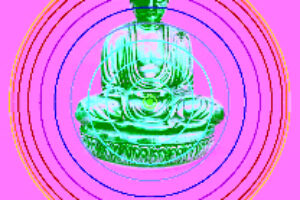
It is an old cliché that the best way to break an old habit is to form a new one. The implication is that a “bad” habit can be replaced by a “good” or at least a “better” one. The idea of good and bad, like right and wrong, is highly relative, of course, and we are instructed (see Fukanzazengi) to set such ideas aside when we do zazen. This is because we have a habit of judging or prejudging things as good or bad on a nearly subliminal level. And to penetrate to a deeper appreciation of the reality of existence, such knee-jerk judgmental thinking must be set aside for the nonce. But as soon as we leave the cushion, we begin to appreciate that in daily life we are constantly beset with issues of right and wrong, good and bad, and relative though they may be, they are not to be gainsaid.
It may be useful to consider more deeply what we mean by good and bad, rather than just assume that we know what is and what isn’t, and that our personal definition would find congruence with that of everyone else, or even God. In the I Ching, or Book of Changes, the ancient divination manual from old China, a translation of interpretation from casting the yarrow stalks might use the word “furthers” for an action that is considered positive, or “does not further” for a situation that is considered negative. So we might want to look at our ideas of good and bad habits in terms of whether they further or do not. The question then becomes, “Further what?”
. In general, if you have any question about whether you are doing enough zazen, the answer is “no.” When you are doing enough, you will know for sure.
zenkai taiun michael elliston, roshi
In a Zen context, and perhaps applicable to life in general, it would be something like furthering our cause to arouse the bodhi-mind, for example, or to make our life more productive and rewarding, and so on. To promote the kinds of “three actions” — of body, mouth, and mind — that are conducive to further development of the three minds: the joyous, the magnanimous, and the nurturing, not necessarily in that order. So the habits that we have carried with us like so much baggage from early childhood on (see last month’s “Intimations”) may be furthering in this regard, or not so much. We can usually tell the difference with a little self-examination and introspection. This becomes painfully acute sometimes when our habitual behaviors and patterns of thought are reflected in the mirror of Zen, which becomes clearer and clearer through the practice of zazen.
The idea of cultivating a habit to replace another habit might apply most readily to a routine that one always falls into at a certain time of day, such as opening that bottle of wine at 5:30, no earlier; but no later than that, either. When one glass leads to one bottle, and one bottle leads to another, a habit may be taking over and becoming an addiction. Or an obsession, if it is not associated with a substance of abuse. Addiction is not always chemical, thought there may be a chemical corollary (“high”) to those not dependent upon a substance.
If there is a regular time that a habit tends to kick in during the routine of the day, which for many is driven by clock-time: commuting to and from work, lunch and other breaks at work, etcetera, then a strategy for countering an undesirable habit might piggyback on the time slot that tends to trigger it. Noticing that at this time every day, my habitual tic is to do a-b-c can suggest trying x-y-z the next time it comes around.
For example, if I usually go and eat (or drink, or smoke) too much for lunch, probably in order to cope with the frustration I feel at my job, what if I try sitting for a while instead — maybe the first 15 minutes of my lunch period — then have a snack. I may find that the sit has an effect on the appetite in a direction I consider furthering.
Why form new habits, after all? A kind of hierarchy of behavior that we may observe in ourselves, say from one extreme:
Self-destructive (to merely)
Anti-Social (to self-imposed)
Isolation (to better)
Integration (to etcetera)
might suggest that habits maybe judged in terms of their effect upon the relationship of the self to others, and that improvements in habits might be expressed in similar terms.
But what about habits that have nothing to do with our relationship to others directly, but more to do with our own sense of self-being in the environment, even in isolation? Many people consider isolation, e.g. in prison, to be cruel and unusual punishment. The fact that it is imposed, and not voluntary, is of course part of the punishment aspect. If one were condemned to never have the possibility of isolation, or even any solitude or privacy, it would surely be just as cruel and unusual.
When we sit in zazen, in one sense we are absolutely alone with our demons, but in another sense we are never alone, even in a cave far from civilization. Whether perceived as alone or in a crowd, there is something that is the same in either case. No one is seeing with our eyes, hearing with our ears, etcetera – we are alone in our world. And yet the world of others impinges upon ours even at a great distance. In any case our habits go with us wherever we go. If we are forced to change habits owing to circumstance, they will tend to resurface in another guise.
Forming a habit of zazen in the midst of this whirl of internal and external activity may seem impossible to some. Finding time to fit zazen into our schedule on a regular basis seems necessary to making it habitual. But what if this is just a habit of thought? What if making a habit of sitting has nothing to do with regularity? The body itself has cycles of regularity, including the familiar use of the term for the rhythms of the digestive system. As an aside, isn’t it interesting to mull the idea that even the most important of human beings, from the most despotic Hitler to the most transcendent religious leader, has to answer when “nature calls”?
The most demanding and compelling habit of choice will be trumped by the most humble of nature’s habits. There are times when it seems beneath our dignity to have to stop some act of overwhelming urgency, immeasurable importance, and potential for posterity, to attend to the inexorable demands of this body. It has no idea of the self-imposed habits we find so irresistible, other than registering some of the deleterious effects of them on its ordinary physical processes, such as the deterioration of the liver and other vital organs.
If we give up the idea of regularity (what if nature calls at the exact moment I am to start zazen?), then we might find a more innovative approach to forming a habit, one that is not dependent upon clock-time, and so “irregular” by definition. If, for example, we sit a bit before lying down to sleep, and a bit after we awake, it really doesn’t matter what time it is. It is the time we sleep, the before-and-after bits. We have hitched our zazen wagon to a biological rhythm, which may not follow the clock, much as we might wish it to do so for social reasons.
Hakuin Zenji suggested not sitting on a full stomach (but only 2/3 full!), so we wouldn’t attempt to form a habit of sitting after meals. But maybe before would do something for our digestion.
Finding the time to sit may be more a matter of discovery than of planning. If we force ourselves into a pattern that we think is the way it is supposed to work, we may simply end up killing off our interest through disappointment in our inability to adhere to the prescribed pattern. If we recognize that the most exquisite pattern would look like chaos, we can be a little looser in our approach. We can “beat the cart” (make the body sit) as Master Dogen suggests, but we do not have to beat it at exactly the same time every day.
Our usual models of discipline are derived from clock-time, conceiving of regularity as something that we do on a daily, weekly, monthly, quarterly, or even annual, basis. It might be of interest to the O-C crowd to actually track the time of day that the body insists on its patterns, to see how they match up to our preconceived idea of regularity. In underground tests, it has been shown that most people revert to a 25-hour circadian cycle, not 24-. Amongst other things, this illustrates that whatever patterns of regularity that we think are normal for us may indeed be compromises with the mechanics of the solar system. A day is an approximate reality, but it is not necessarily natural to us.
So forming a habit of practicing zazen may require a revolution in our thinking about time itself. How much time does it take to do zazen? Any answer would be arbitrary. The averages that we see in people’s practice patterns are just that. We can ramp up the intensity by manipulating the quantity, but it does not necessarily translate into a qualitative benefit.
Though we cannot really know how much time it takes, it doesn’t mean we shouldn’t try to find out. In general, if you have any question about whether you are doing enough zazen, the answer is “no.” When you are doing enough, you will know for sure.
But enough is not measurable by clock-time. When one enters into real time through zazen, it is clear and undeniable. Then we have all the time there is. Time is all we have.
When zazen finally becomes habitual, the nature of your relationship to zazen changes in a fundamental way. A habit no longer requires any real thought or intention. We behave habitually even though we may not perceive any benefit. A habit is repetitious, even though it may not be regular, so it loses its meaning. Anything repeated enough becomes relatively meaningless, second nature, doing nothing. Being unconscious and unintentional, zazen can then begin to have its deeper effect. As Master Dogen says somewhere, “Sitting buddha does not hinder buddha.” Not only does zazen not hinder the action of buddha in our life, our misbegotten ideas about it can not forever get in the way.
When zazen becomes habitual for you, it may also replace a lot of other habits you did not even recognize as such. Among the other benefits that may not be apparent in your present struggle with monkey mind zazen, you will find no resistance or conflict with other possible choices of what you could be doing with your time instead of zazen. You will be entirely comfortable with investing the kind of time and effort required to make any real progress in your practice because you will not be “such a busy person” to borrow from Hasegawa Sensei (“Cave of Poison Grass”). You will find yourself embracing the various kinds of discomfort — physical, mental, emotional, and social — that you may now find forming excuses not to do zazen, and leading to other habits not as furthering.
When zazen becomes habitual, it is not necessarily regular. Sheer repetition, in any circumstance, at any time and place, comes to replace your old ideas of discipline. The zazen habit does not depend upon duration — how long you sit; frequency — how often; or regularity — how addicted you are to the clock. Sheer repetition looms over all other parameters and in fact frees your zazen from them. How still you sit, on a relative basis, fades into irrelevancy compared to the fact that you never give up, and allow yourself to sit whenever you get to. All of these are misconceptions about zazen conjured up by a society that tries to approach Zen and zazen the way it tries to do everything else.
Zen and zazen cannot be captured by these constraints. It is not Indian, Chinese, Japanese, or American. It cannot be corked in a cultural bottle. It has nothing to do with measured time and space, or any other and all concepts of the monkey mind.
This is illustrated by the questions that people always ask about Zen, e.g. how to apply it to daily life. We cannot apply Zen to anything. But if you apply yourself to Zen, Zen will apply itself to your daily life.
We speak of entering into real time, real space, in Zen — entering into stillness. This stillness is not only physical, e.g. the zazen posture, the quiet zendo. This stillness is also the abdication and abnegation of the monkey mind, the idea that we know what stillness is. As Master Dogen reminds us, this does not appear within perception, because it is “unconstructedness in stillness”… and that “in stillness, mind and object merge in realization and go beyond enlightenment.”
To become free of the constraints of monkey mind and enter into this kind of stillness, zazen has to become habitual so as to be unconstructed. Our being is habitually in Samadhi; it is its habit to be still. We need to form the habit of not disturbing it.









